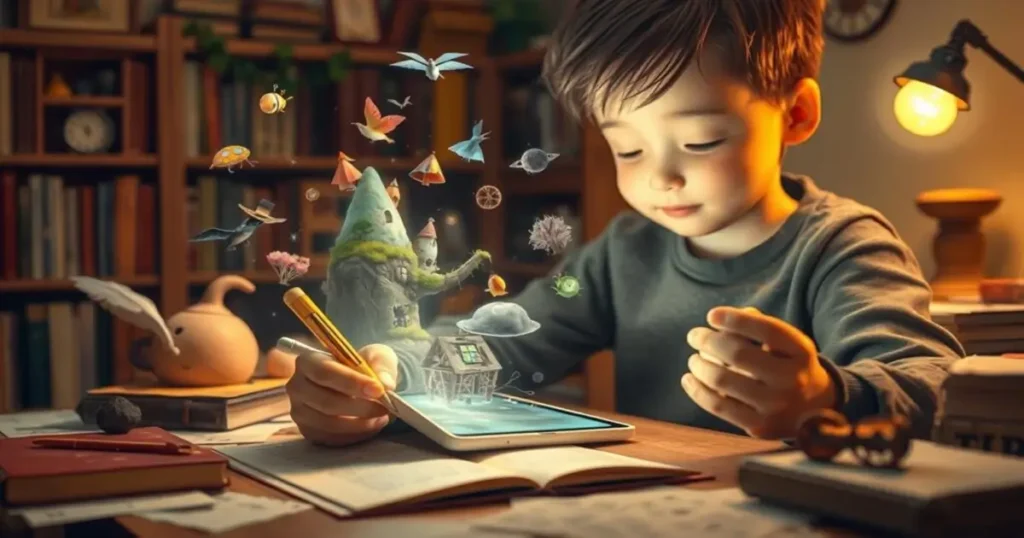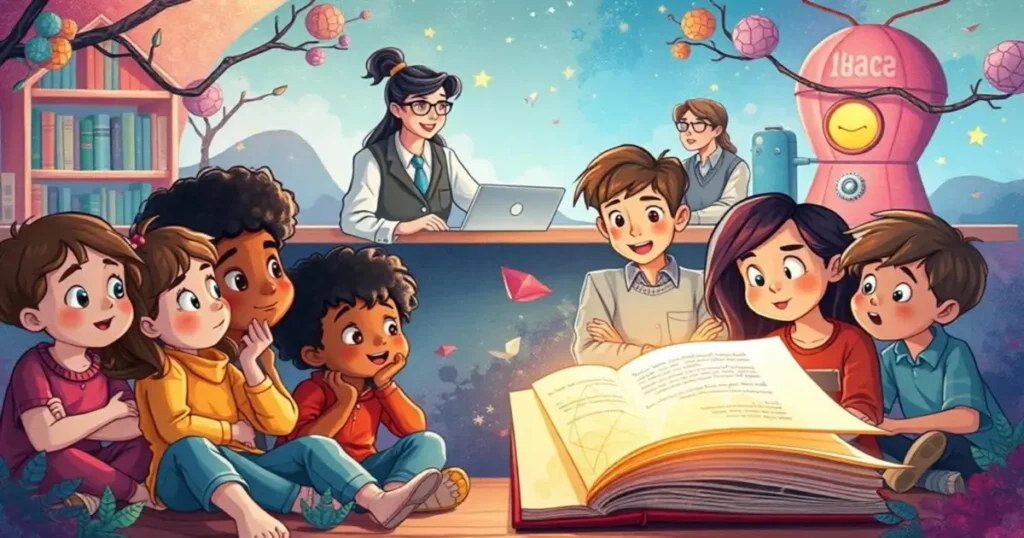The world of children’s books is changing fast with AI. Now, writers have tools that make creating books easier and more fun. These tools help writers work faster and think more creatively.
Tools like ChatGPT and Midjourney are making a big difference. They help writers come up with ideas, write stories, and even make pictures. This all happens quickly and with great detail.
In this guide, we’ll show you how to use AI to write children’s books. We’ll talk about how to use new technology without losing the magic of stories. We’ll cover everything from the first idea to the finished book, showing how AI can help.
Table of Contents
Understanding AI Tools for Children’s Book Creation
The world of children’s book making has changed a lot thanks to new AI tools. These tools help writers and illustrators work more efficiently.
Looking into AI for book making shows us a world of new tools. These tools change how we tell stories for kids. They make writing and drawing better than ever.
Popular AI Writing Platforms
Writers can use powerful AI platforms to create great stories. Some top tools are:
- ChatGPT: A smart text generator
- OpenAI’s GPT models: Top language tools
- Jasper AI: Great for creative writing
AI Image Generation Tools
AI has also changed how we make pictures for stories. Key tools include:
- DALL·E 3: Creates images from text
- Midjourney: Makes cool visuals
- Stable Diffusion: An open-source tool
Limitations and Capabilities
AI tools are amazing, but they have limits. Creators need to guide these tools and add their own touch to make great kids’ books. It’s important to keep working on AI content to make it the best it can be.
AI image tools have seen billions of pictures online. This raises big questions about ethics. Writers should use these tools wisely and respect others’ work.
Getting Started with AI Children’s Book Writing
Starting your journey in AI children’s book writing is exciting and new. By October 31, 2023, AI tools for kids’ writing have grown a lot. This guide will show you how to use AI to create children’s books.
Choosing the right tools is key when you start writing children’s books with AI. Look into different AI platforms that can help with your writing:
- ChatGPT for starting your story
- Claude from Anthropic for better language
- Leonardo AI for making images
- Adobe Firefly for illustrations
Setting Up Your Writing Environment
Setting up a good AI writing space is important. Pick a quiet place to work. Install your AI tools and learn how to use them. Use ProWriting Aid for grammar checks.
Choosing the Right AI Tools
AI tools are good at different things in children’s book making. Large Language Models (LLMs) like Google’s Gemini and Microsoft’s Copilot are great. AI can start your story, but your creativity is what makes it special.
Planning Your Story Structure
A good story structure is essential. Use AI to brainstorm, but add your own ideas. AI can give you many story options, so pick the best one.
Pro Tip: Always review and refine AI-generated content to ensure it meets the unique requirements of children’s literature.
How to Write Children’s Book Using AI
Writing a children’s book with AI is a new way for authors to start. We pick the best AI tools and learn what they can do. This journey involves planning and working together creatively.
- Choose an AI writing platform that works for kids’ stories
- Decide on your story’s main idea and who it’s for
- Make detailed descriptions of your characters
- Start writing with AI prompts
- Make the AI content your own
AI can make writing books much faster. Traditional publishing takes 18-24 months, but AI can do it in 14 days. It’s about using AI’s power while keeping your creative touch.
Use simple, clear language that kids can understand. Children’s books should be short and fun. Try out different AI tools to see which fits your story best.
AI is just a tool, not a replacement for your creativity. Your unique voice and story ideas are what make a book special.
Crafting Effective AI Prompts for Story Generation
To make great ai-generated kids’ stories, you need to learn how to write good prompts. We’re going to explore how to talk to AI tools in a way that works.

Writing good prompts is like giving an artist clear directions. You need to give AI specific details so it gets your story right.
Writing Clear and Specific Prompts
For kids’ book content, your prompts should have:
- Precise age group targeting
- Specific story themes
- Desired emotional tone
- Character background details
“The magic of AI storytelling happens when human creativity meets technological precision.”
Refining AI-Generated Content
AI text often needs a bit of work. Our plan is to:
- Read the first draft carefully
- Find parts that need human touch
- Edit for the right language for kids
- Make sure the story flows well
Maintaining Consistent Tone and Voice
Keeping a steady voice in AI stories is key. We suggest:
- Make sure characters are clear
- Use the same language style
- Choose words that fit the age
- Check different AI versions
Remember, AI is a powerful tool, but your creative vision is the heart of the story.
Creating AI-Generated Illustrations
AI tools have changed how we make children’s book illustrations. They offer new ways for authors to make their stories come alive. This journey into ai and children’s book illustration shows us exciting new paths for creative people.
Midjourney and DALL-E are top choices for kids’ book authors. They let creators make unique pictures with just text prompts. We can make illustrations that show off our imagination with great detail.
- Select an AI image generation platform
- Write detailed, descriptive prompts
- Experiment with different artistic styles
- Refine generated images iteratively
Creating great AI illustrations needs a smart plan. Precision in prompt crafting determines image quality. Authors must tell the AI exactly what they want, from character looks to scene setup.
| AI Tool | Strengths | Limitations |
|---|---|---|
| Midjourney | High-quality artistic renderings | Complex character consistency |
| DALL-E | Diverse image generation | Limited fine-tuning options |
| Stable Diffusion | Open-source flexibility | Requires technical knowledge |
“AI illustration tools are transforming storytelling, opening up new creative possibilities for authors.”
Even with AI’s amazing visuals, our own creativity is key. We suggest mixing AI-made pictures with our own touch to make books that stand out.
Editing and Refining AI-Generated Content
Creating a polished children’s book with AI starts with editing and refinement. AI tools are great for a first draft, but a human touch is key. It turns raw content into a story that kids will love.
Our method for improving AI writing for kids involves several steps. We aim to make AI content better:
Maintaining Story Coherence
Coherence is vital for a good children’s story. Here’s how we handle AI text:
- Read the draft many times
- Check if the story flows well
- Make sure characters act consistently
- Get rid of parts that don’t make sense
Ensuring Age-Appropriate Content
Choosing the right words and themes is key for kids’ books. Here’s what we do:
- Check if the words fit the age group
- Remove anything that’s not right for kids
- Make sure the story touches their hearts
Final Polishing Techniques
Refining AI content needs careful attention. Here are our top tips:
| Technique | Purpose |
|---|---|
| Sentence Structure Variation | Make it easier and more fun to read |
| Contextual Editing | Make sure it fits the story’s message |
| Emotional Depth Enhancement | Make the story more meaningful |
“Editing turns AI drafts into stories that kids will love.”
With these steps, we can make AI drafts into books that kids will enjoy. They become stories that capture young imaginations.
Publishing Your AI-Assisted Children’s Book
AI is changing how we publish kids’ books. It makes creating books easier than ever. Now, anyone can become an author.
Exploring AI in children’s publishing shows us different ways to publish:
- Self-publishing platforms like Amazon Kindle Direct Publishing (KDP)
- Print-on-demand services
- Digital-first publishing channels
Getting your AI-assisted children’s book out there is fast. Traditional publishing takes 18-24 months. But AI can do it in about 14 days.
| Publishing Method | Time Required | Cost Considerations |
|---|---|---|
| Traditional Publishing | 18-24 months | High editorial and marketing costs |
| AI-Assisted Self-Publishing | 14 days | Low initial investment |
When you publish your AI book, be open about how it was made. People like to know about the AI’s role. Amazon KDP is a great place to share your AI book.
AI helps make books faster, but human touch is key. Good editing and original stories make your book stand out.
Remember, AI is a tool to enhance creativity, not replace it.
Our study found AI can help authors create books quickly. For example, Ammaar Reshi wrote a whole book in one weekend. The secret is using AI wisely to tell real stories.
Legal and Ethical Considerations
The use of AI in children’s books has raised many questions about legal and ethical issues. As we look into ai and children’s literature, we must be careful. We need to understand the rules of intellectual property and who is responsible for creative work.

AI in making children’s books brings new challenges for writers, publishers, and creators. It’s important to know the laws to use AI responsibly in writing.
Copyright and Licensing Challenges
AI in children’s publishing has brought up big legal issues:
- Amazon KDP now asks authors to say if their work was made with AI
- 17 authors sued OpenAI in 2023 for possible copyright problems
- The Alliance of Independent Authors (ALLi) made rules for using AI ethically
Attribution and Transparency Standards
Being open is key when using AI tools. Here’s what we suggest:
- Always say if AI helped create the content
- Check the content for plagiarism
- Make sure a human has edited and checked the work
| AI Content Type | Ethical Considerations | Recommended Action |
|---|---|---|
| AI-Generated Content | Minimal human intervention | Disclose fully, obtain necessary permissions |
| AI-Assisted Content | Significant human editing | Cite AI tools used, maintain creative integrity |
Industry Best Practices
As AI changes children’s books, following ethical rules is key. Responsible innovation means using new tech while respecting ideas and work.
Conclusion
Our journey into using AI for children’s books shows a new world for storytelling. AI has changed how we write and publish books, making it faster and more open. This change is shaking up old ways of publishing.
AI tools help writers create stories and pictures fast. Now, making books takes just two weeks, down from 18-24 months. This means we can make books for all ages, from picture books to young adult novels, quickly.
But, we must remember AI is a helper, not a replacement for human creativity. The best children’s books come from a mix of AI and human touch. AI can help with ideas and speed up work, but human authors bring the heart and unique views that make stories special.
Looking ahead, success in AI-assisted book making depends on knowing its strengths and weaknesses. By using AI wisely, authors can create stories that excite and inspire kids in new ways.